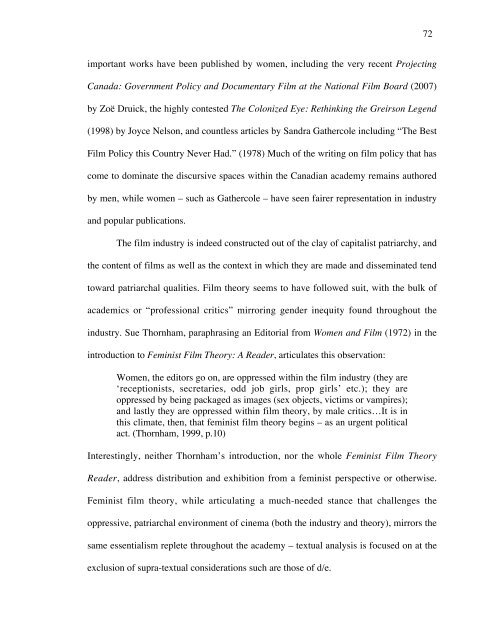The Spaces Between Grassroots Documentary ... - Ezra Winton
The Spaces Between Grassroots Documentary ... - Ezra Winton
The Spaces Between Grassroots Documentary ... - Ezra Winton
You also want an ePaper? Increase the reach of your titles
YUMPU automatically turns print PDFs into web optimized ePapers that Google loves.
important works have been published by women, including the very recent Projecting<br />
Canada: Government Policy and <strong>Documentary</strong> Film at the National Film Board (2007)<br />
by Zoë Druick, the highly contested <strong>The</strong> Colonized Eye: Rethinking the Greirson Legend<br />
(1998) by Joyce Nelson, and countless articles by Sandra Gathercole including “<strong>The</strong> Best<br />
Film Policy this Country Never Had.” (1978) Much of the writing on film policy that has<br />
come to dominate the discursive spaces within the Canadian academy remains authored<br />
by men, while women – such as Gathercole – have seen fairer representation in industry<br />
and popular publications.<br />
<strong>The</strong> film industry is indeed constructed out of the clay of capitalist patriarchy, and<br />
the content of films as well as the context in which they are made and disseminated tend<br />
toward patriarchal qualities. Film theory seems to have followed suit, with the bulk of<br />
academics or “professional critics” mirroring gender inequity found throughout the<br />
industry. Sue Thornham, paraphrasing an Editorial from Women and Film (1972) in the<br />
introduction to Feminist Film <strong>The</strong>ory: A Reader, articulates this observation:<br />
Women, the editors go on, are oppressed within the film industry (they are<br />
‘receptionists, secretaries, odd job girls, prop girls’ etc.); they are<br />
oppressed by being packaged as images (sex objects, victims or vampires);<br />
and lastly they are oppressed within film theory, by male critics…It is in<br />
this climate, then, that feminist film theory begins – as an urgent political<br />
act. (Thornham, 1999, p.10)<br />
Interestingly, neither Thornham’s introduction, nor the whole Feminist Film <strong>The</strong>ory<br />
Reader, address distribution and exhibition from a feminist perspective or otherwise.<br />
Feminist film theory, while articulating a much-needed stance that challenges the<br />
oppressive, patriarchal environment of cinema (both the industry and theory), mirrors the<br />
same essentialism replete throughout the academy – textual analysis is focused on at the<br />
exclusion of supra-textual considerations such are those of d/e.<br />
72


